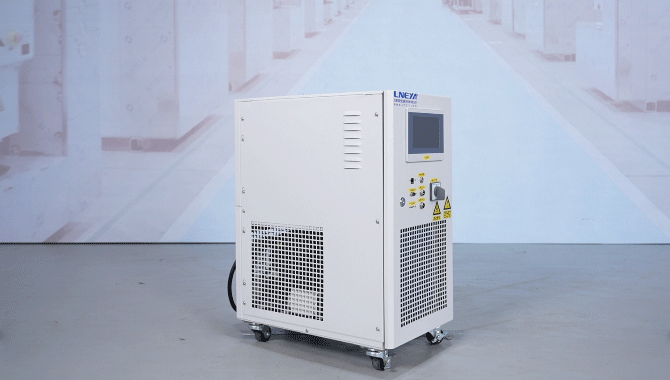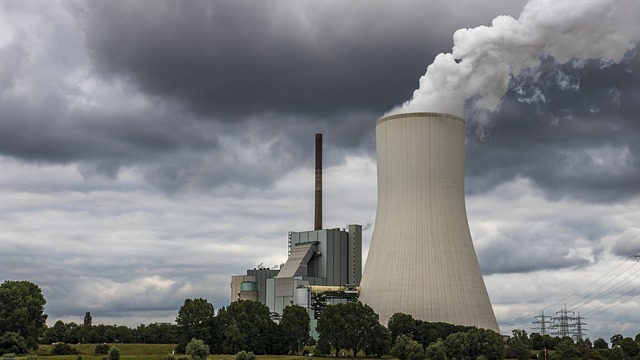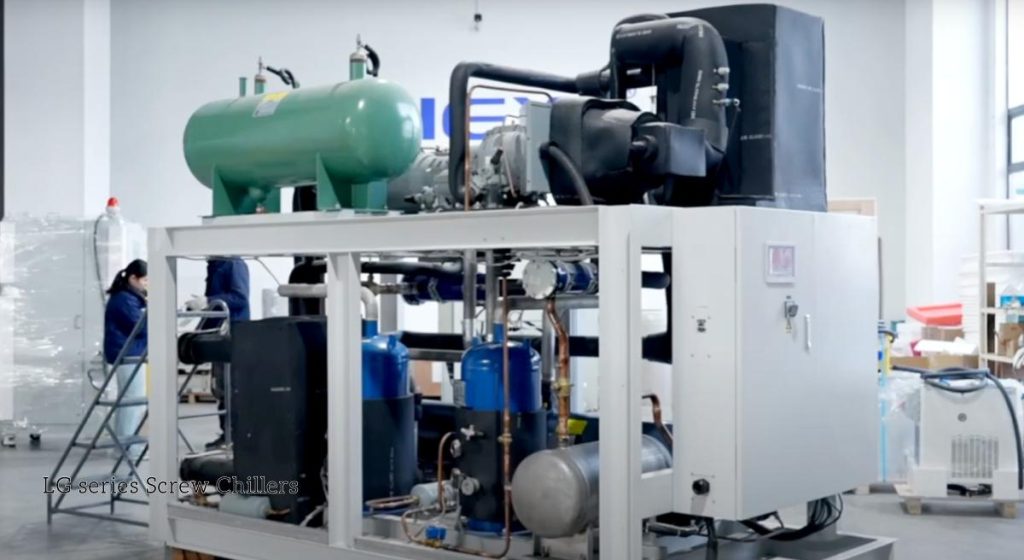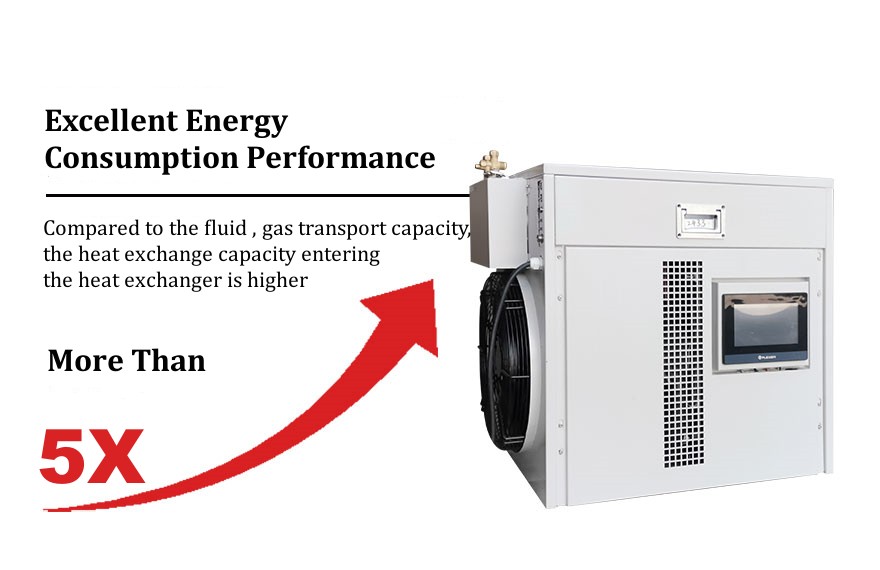Was ist der Unterschied zwischen Chillern und Kühlern
In einer Halbleiterfabrik muss das Prozesswasser oft bei etwa 10 °C gehalten werden. Ein kleiner Luftkühler kann diese Temperatur nicht halten; er kann die Flüssigkeit einfach nicht unter die Raumtemperatur senken. Drehen wir die Situation um: Eine Hydraulikpresse in einer Werkstatt erzeugt tagsüber nur wenig Wärme. Einen kompletten Industrie-Chiller daraufzusetzen wäre unnötig und teuer.
Deshalb ist die Unterscheidung zwischen Chillern und Coolern wichtig. Es geht darum, ob die Ausrüstung zur tatsächlichen täglichen Arbeitsweise einer Fabrik, eines Labors oder einer Maschine passt.
Was ist ein Kältemaschine?
Ein Chiller arbeitet nach dem Kältekreislauf und verwendet bekannte Komponenten wie Kompressor, Kondensator, Verdampfer und Expansionsventil. Anstatt nur Wärme abzuleiten, erzeugt er aktiv gekühltes Wasser oder eine Glykol-Lösung, die weit unter der Temperatur der Umgebungsluft bleiben kann.
Chiller können in luftgekühlten Ausführungen gebaut werden, die Wärme an die Atmosphäre abgeben, oder in wassergekühlten Versionen, die an Kühltürme angeschlossen werden. Man findet sie in vielen Branchen—Labors, Halbleiterwerke, Krankenhäusern und sogar in Kunststoffspritzereien.
Die wahre Stärke eines Chillers liegt in der Steuerung. Er kühlt nicht nur Wasser; er ermöglicht es den Bedienern, einen Sollwert einzustellen und zu halten, was in Prozessen, in denen Stabilität die Produktqualität direkt beeinflusst, entscheidend ist.

Was ist ein Kühler?
Es gibt keinen Kompressor und keinen Kältekreislauf.
Betrachten Sie den Ölkühler an einer hydraulischen Presse, den Luftkühler an einer CNC-Maschine oder sogar den Kühler in einem Auto. Alle arbeiten nach demselben Prinzip: die Flüssigkeit darf im Vergleich zur Umgebungsluft nicht zu heiß werden. Was sie nicht können, ist, sie unter die Raumtemperatur zu kühlen.
Die Einfachheit ist Teil ihres Reizes. Kühler sind leichter, günstiger und in der Regel einfacher in Betrieb und Wartung als Chiller. Für viele Fabriken reicht das aus, um zu verhindern, dass die Ausrüstung während langer Produktionsläufe überhitzt. Wenn ein Prozess jedoch Temperaturen unterhalb der Raumtemperatur erfordert, reicht ein Kühler allein nicht aus.

Key differences between chillers and coolers
Funktionsprinzip
Ein Chiller arbeitet nach einem Kältekreislauf. Im Inneren arbeiten ein Kompressor, ein Kondensator und ein Verdampfer zusammen, um Wärme aus dem Prozessfluid zu entziehen. Anstatt nur Wärme abzuleiten, erzeugt er gekühltes Wasser — oder manchmal eine Glykolmischung —, das auf einer festgelegten Temperatur gehalten wird.
Ein Kühler hingegen senkt das Fluid nie unter die Umgebungstemperatur. Er überträgt lediglich Wärme über einen Wärmetauscher in die umgebende Luft oder das Wasser und bringt das Prozessfluid näher auf Raumtemperatur.
Temperaturbereich
Chiller können weit unter die Umgebungstemperatur kühlen und halten Wasser je nach Bedarf von 25–30 °C für leichte Kühlung bis nahezu gefrierpunktnah für anspruchsvolle Prozesse.
Ein Kühler hingegen ist an die Temperatur des Raums oder der Außenluft gebunden. Liegt die Temperatur auf dem Werkstattboden bei 30 °C, liegt das Ausgangswasser eines Kühlers nur wenige Grad darüber, meist um 32–33 °C.
Kühlmedium
Chiller zirkulieren normalerweise eine kontrollierte Flüssigkeit wie Kühlwasser, Sole oder eine Glykolmischung. Dieselbe Flüssigkeit durchläuft das System immer wieder, entzieht empfindlicher Ausrüstung Wärme und bleibt nahe am Sollwert.
Kühler hingegen verwenden keine speziellen Lösungen. Sie arbeiten einfach mit dem vorhandenen Prozessfluid – Öl in einer Presse, Schmierstoffe in Getrieben oder einfaches Wasser im Maschinenkreislauf.
Kosten
Chiller verbrauchen mehr Strom, bieten jedoch eine präzise Temperaturregelung und die Anpassungsfähigkeit für eine breite Palette von Anwendungen. In Branchen, in denen gleichmäßige Kühlung direkt die Produktqualität beeinflusst, lohnt sich diese Investition oft.
Kühler hingegen sind günstiger in Anschaffung und Betrieb. Ohne Kompressoren oder Kältemittelsysteme bleibt ihr Energieverbrauch minimal. Sie werden oft gewählt, wenn das Ziel lediglich darin besteht, überschüssige Wärme abzuleiten, anstatt eine strikte Temperaturkontrolle zu erreichen.
Anwendungen
Chiller kommen dort zum Einsatz, wo Präzision wichtig ist. Krankenhäuser nutzen sie, um MRT-Geräte bei stabilen Temperaturen zu halten. Halbleiterfabriken sind auf sie angewiesen, um Prozesswasser innerhalb enger Grenzen zu halten. In der Pharmaindustrie benötigen Reaktoren Chiller, um die Reaktionswärme zu kontrollieren. Sogar beim Kunststoffspritzguss sorgt gekühltes Wasser dafür, dass die Teile mit gleichbleibender Qualität hergestellt werden.
In einer Hydraulikpresse hält ein Kühler das Öl während langer Betriebszeiten vor Überhitzung. Für einfachere Maschinen reicht ein einfacher Kühler oft aus, um vor Wärmeaufbau zu schützen.

Englische Szenarien: wie die Begriffe verwendet werden
Die englische Terminologie kann zu Verwirrung führen. In den meisten technischen Zusammenhängen bezeichnet „Kältemaschine“ speziell ein auf Kälte basierendes System. „Kühler“ hingegen kann eine breite Palette von Geräten beschreiben — von einem einfachen Autokühler oder tragbaren Eisbehälter bis zu einem industriellen Wärmetauscher.
Zum Beispiel könnte ein amerikanischer Ingenieur sagen: „Wir brauchen einen industriellen Chiller für unsere Laserliste“, während in einem anderen Kontext jemand sagt: „Installiere einen industriellen Kühler zum Schutz des Getriebes.“ Beides ist korrekt, beschreibt jedoch sehr unterschiedliche Lösungen.
Beim Online-Einkauf von Ausrüstung bedeutet „industrieller Chiller“ fast immer kältebasierte Geräte, während „industrieller Kühler“ alles von einer Luftblaseneinheit bis zu einem Kühlturm bezeichnen kann.
Wie wählt man zwischen einem Chiller und einem Cooler?
Die Entscheidung hängt von den Temperaturanforderungen des Prozesses ab.
Wenn Ihr Betrieb Wasser kälter als die Umgebung benötigt oder eine stabile, präzise Kontrolle erfordert, ist ein Chiller die einzige wirkliche Wahl. Beispielsweise können Halbleiterfertigung oder medizinische Bildgebung keine instabilen Temperaturen riskieren.
Wenn Ihre Ausrüstung nur warm läuft und Sie sie nur in der Nähe der Raumtemperatur halten müssen, ist ein Cooler kostengünstiger. Eine hydraulische Presse in einer Werkstatt benötigt oft nur einen Öl-Kühler.
Weitere Faktoren sind ebenfalls wichtig:
• Budget: Chiller sind eine Investition, während Cooler normalerweise günstiger sind.
• Energieverfügbarkeit: Chiller verbrauchen mehr Strom. In Gebieten mit Strombegrenzungen können Cooler praktischer sein.
• Wartung: Chiller benötigen regelmäßige Wartung von Kompressoren und Kältemittel, während Cooler normalerweise weniger Aufmerksamkeit erfordern.
Als Faustregel gilt: Wenn der Prozess präzise, stabile Kühlung erfordert, wählen Sie einen Chiller. Wenn nur allgemeine Wärmeabfuhr nötig ist, reicht ein Cooler aus.
Schlussfolgerung
Hat Ihnen dieser Artikel wirklich geholfen, den Unterschied zwischen einem Chiller und einem Cooler zu verstehen? Wenn Sie feststellen, dass Ihr Projekt einen Industrie-Chiller benötigt, der eine stabile Temperatur halten kann, empfiehlt LNEYA gerne ein geeignetes Modell oder entwickelt ein einzigartiges Kühlsystem basierend auf Ihren Anwendungsanforderungen. Kontaktieren Sie uns, um Ihre zuverlässige Temperaturkontrollerfahrung zu starten.

- Temperature Control in Photolithography
- Is a Used Chiller a Good Idea
- Chiller Components and Refrigeration Fundamentals Guides
- Chiller Types and Selection Guides
- How Does a Peltier Cooler Work
- Peltier Chiller vs. Compressor Chiller
- What Is a Peltier Chiller
- OEM vs Aftermarket Chiller Spare Parts
- Dezember 2025
- November 2025
- Oktober 2025
- September 2025
- August 2025
- Juli 2025
- Juni 2025
- Mai 2025
- März 2025
- Februar 2025
- Januar 2025
- Dezember 2024
- November 2024
- Oktober 2024
- September 2024
- August 2024
- Juli 2024
- Juni 2024
- Mai 2024
- April 2024
- März 2024
- Februar 2024
- September 2023
- Juli 2023
- Juni 2023
- Mai 2023
- Januar 2023
luftgekühlte Kältemaschine Kühler Installation der Kältemaschine Wartung von Kühlanlagen chiller refrigerant Kältemaschinen Kalte Montage Gefrierschrank Kaltwassersatz Kühl-Heizsystem cooling system dynamisches Temperaturkontrollsystem energieeffizienter Chiller explosionsgeschützter Kühler Gefrierschrank Heizungsumwälzpumpe Industriekühler Industriekälteanlagen Industriekühlung industrieller Gefrierschrank Industriekühlschrank Mantelreaktor Laborkühlschrank Niedertemperaturkühler Nachrichten Ölkühler Prozesskühler process cooling Reaktorkühler Reaktorkühlung Reaktorkühlung Heizung Reaktorheizung Kühlung Kältethermostat Schneckenkühler Halbleiter-Kühlgerät Halbleiter-Testkühler sundi tcu Temperaturkontrolle Prüfkammer Thermostat Ultra-Niedertemperatur-Kühler Fahrzeug-Test-Kühler Kaltwassersatz wassergekühlte Kältemaschine
Verwandte Chiller
KONTAKT US
TEL:
EMAIL:
WeChat & WhatsApp:

Wechat QR

Haben Sie eine Frage oder benötigen Sie ein Angebot? Füllen Sie das untenstehende Formular aus, und unser Team wird sich innerhalb von 24 Stunden bei Ihnen melden.
 LNEYA Industriekühler Hersteller Lieferant
LNEYA Industriekühler Hersteller Lieferant
















